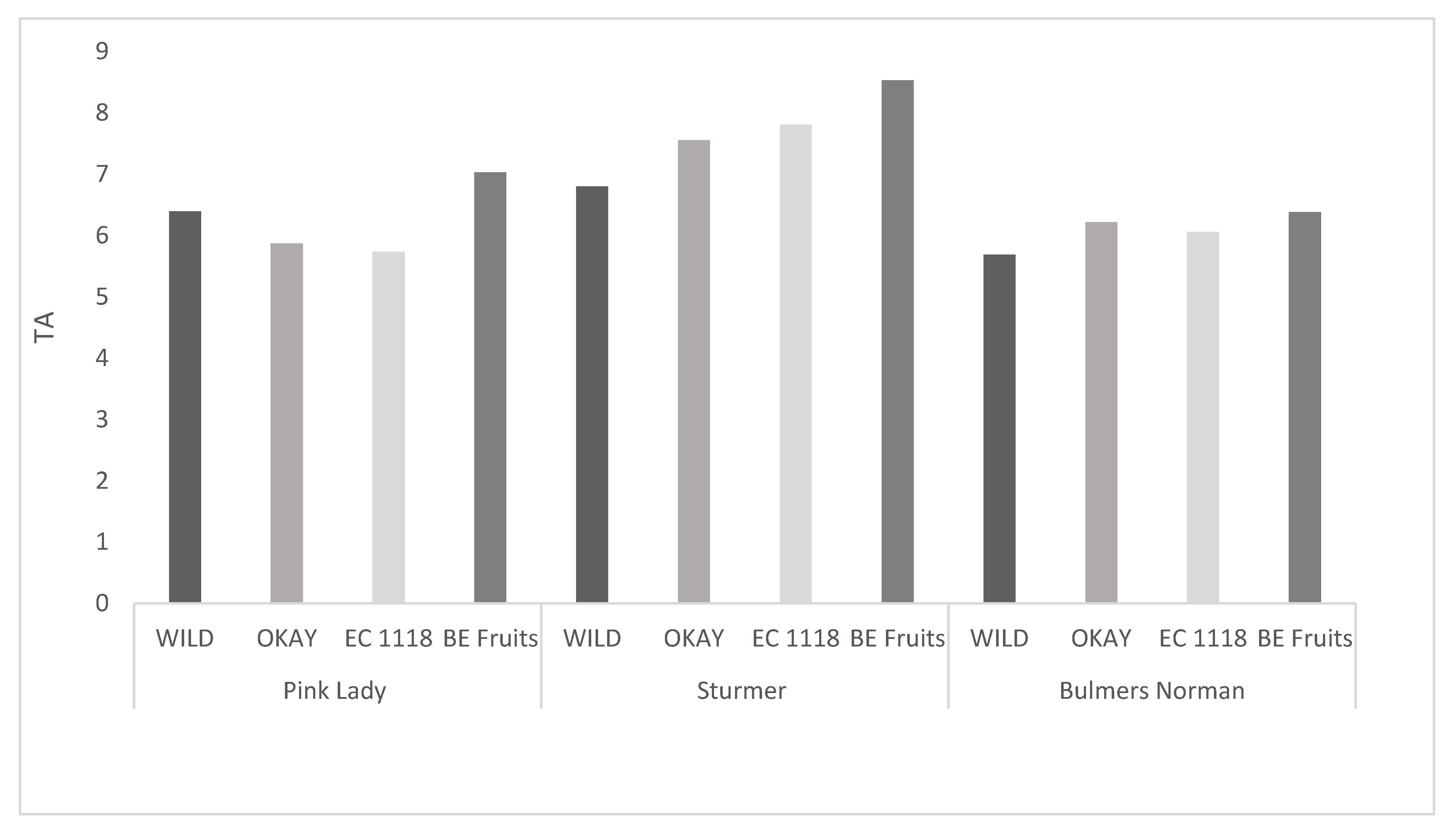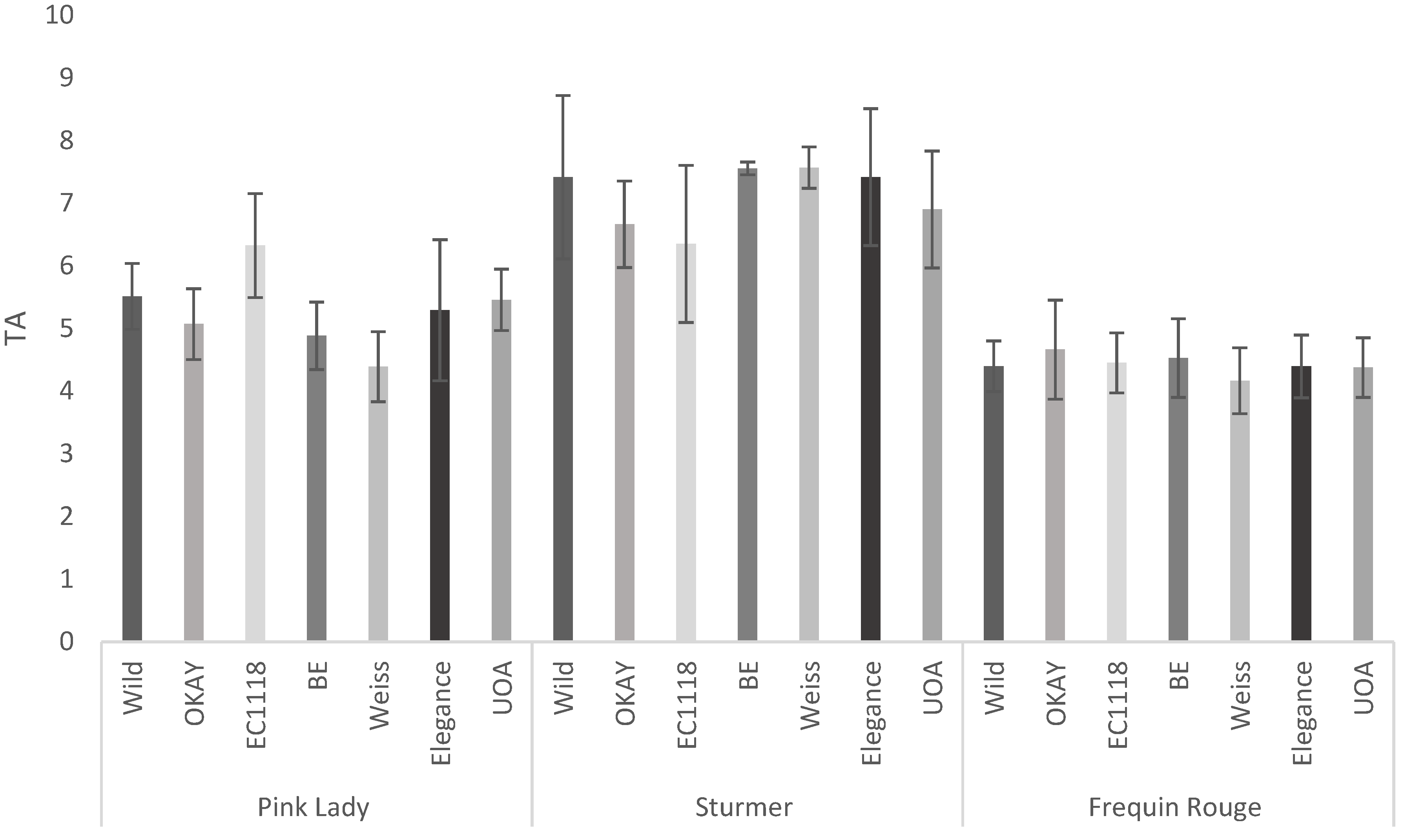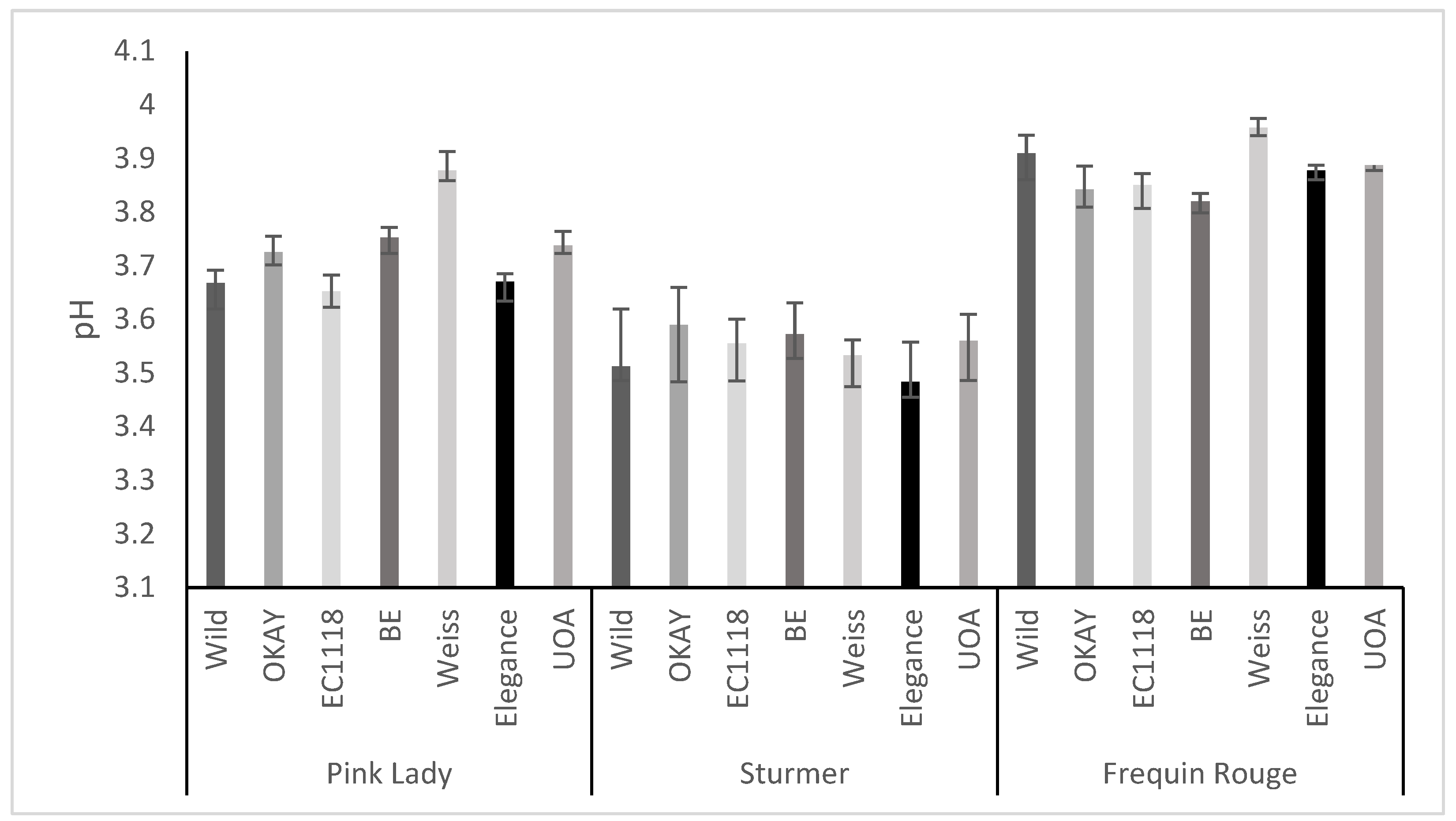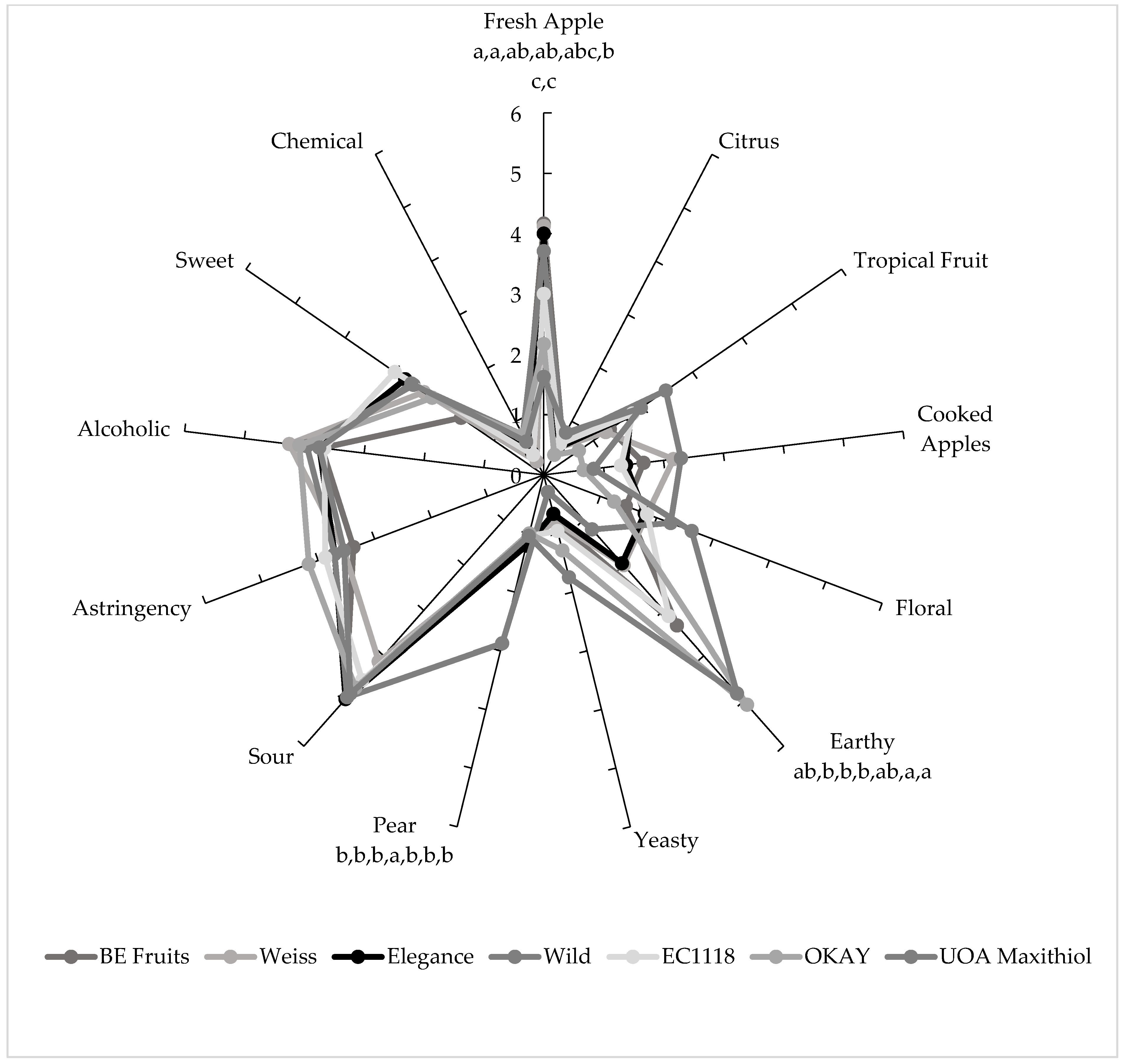A Preliminary Study of Yeast Strain Influence on Chemical and Sensory Characteristics of Apple Cider
Abstract
:1. Introduction
2. Materials and Methods
2.1. Cider Making
2.2. Chemical Analysis
2.3. Descriptive Sensory Analysis
Sensory Training
2.4. Statistical Analysis
3. Results and Discussion
3.1. Base Cider Parameters
3.1.1. Titratable Acidity (TA)
3.1.2. pH
3.1.3. Total Phenolic Content (TPC)
3.2. Sensory Analysis
4. Conclusions
Supplementary Materials
Author Contributions
Funding
Institutional Review Board Statement
Informed Consent Statement
Data Availability Statement
Acknowledgments
Conflicts of Interest
References
- Barnett, J.A. A history of research on yeasts 2: Louis Pasteur and his contemporaries, 1850–1880. Yeast 2000, 16, 755–771. [Google Scholar] [CrossRef]
- Dashko, S.; Zhou, N.; Compagno, C.; Piškur, J. Why, when, and how did yeast evolve alcoholic fermentation? FEMS Yeast Res. 2014, 14, 826–832. [Google Scholar] [CrossRef]
- Leguerinel, I.; Mafart, P.; Cleret, J.; Bourgeois, C. Yeast strain and kinetic aspects of the formation of flavour components in cider. J. Inst. Brew. 1989, 95, 405–409. [Google Scholar] [CrossRef]
- Liu, S.-Q.; Aung, M.T.; Lee, P.-R.; Yu, B. Yeast and volatile evolution in cider co-fermentation with Saccharomyces cerevisiae and Williopsis saturnus. Ann. Microbiol. 2016, 66, 307–315. [Google Scholar] [CrossRef]
- Bisson, L.F. The biotechnology of wine yeast. Food Biotechnol. 2004, 18, 63–96. [Google Scholar] [CrossRef]
- Romano, P.; Ciani, M.; Fleet, G.H. Yeasts in the Production of Wine; Springer: Berlin, Germany, 2019. [Google Scholar]
- Lorenzini, M.; Simonato, B.; Slaghenaufi, D.; Ugliano, M.; Zapparoli, G. Assessment of yeasts for apple juice fermentation and production of cider volatile compounds. LWT 2019, 99, 224–230. [Google Scholar] [CrossRef]
- Romano, P.; Fiore, C.; Paraggio, M.; Caruso, M.; Capece, A. Function of yeast species and strains in wine flavour. Int. J. Food Microbiol. 2003, 86, 169–180. [Google Scholar] [CrossRef]
- Pretorius, I.S.; Høj, P.B. Grape and wine biotechnology: Challenges, opportunities and potential benefits. Aust. J. Grape Wine Res. 2005, 11, 83–108. [Google Scholar] [CrossRef]
- Howell, K.S.; Cozzolino, D.; Bartowsky, E.J.; Fleet, G.H.; Henschke, P.A. Metabolic profiling as a tool for revealing Saccharomyces interactions during wine fermentation. FEMS Yeast Res. 2006, 6, 91–101. [Google Scholar] [CrossRef]
- Swiegers, J.H.; Pretorius, I.S. Yeast modulation of wine flavor. Adv. Appl. Microbiol. 2005, 57, 131–175. [Google Scholar]
- Wei, J.; Zhang, Y.; Wang, Y.; Ju, H.; Niu, C.; Song, Z.; Yuan, Y.; Yue, T. Assessment of chemical composition and sensorial properties of ciders fermented with different non-Saccharomyces yeasts in pure and mixed fermentations. Int. J. Food Microbiol. 2020, 318, 108471. [Google Scholar] [CrossRef]
- Al Daccache, M.; Koubaa, M.; Maroun, R.G.; Salameh, D.; Louka, N.; Vorobiev, E. Impact of the physicochemical composition and microbial diversity in apple juice fermentation process: A Review. Molecules 2020, 25, 3698. [Google Scholar] [CrossRef]
- Ugliano, M.; Henschke, P.A. Yeasts and wine flavour. In Wine Chemistry and Biochemistry; Springer: Berlin, Germany, 2009; pp. 313–392. [Google Scholar]
- Wei, J.; Zhang, Y.; Qiu, Y.; Guo, H.; Ju, H.; Wang, Y.; Yuan, Y.; Yue, T. Chemical composition, sensorial properties, and aroma-active compounds of ciders fermented with Hanseniaspora osmophila and Torulaspora quercuum in co-and sequential fermentations. Food Chem. 2020, 306, 125623. [Google Scholar] [CrossRef]
- Rosend, J.; Kuldjärv, R.; Nisamedtinov, I.; Arju, G. Yeast Performance Characterisation in Different Cider Fermentation Matrices. Agron. Res. 2019, 17. [Google Scholar] [CrossRef]
- Rosend, J.; Kuldjärv, R.; Rosenvald, S.; Paalme, T. The effects of apple variety, ripening stage, and yeast strain on the volatile composition of apple cider. Heliyon 2019, 5, e01953. [Google Scholar] [CrossRef]
- Mangas, J.; Cabranes, C.; Moreno, J.; Gomis, D. Influence of cider-making technology on cider taste. LWT-Food Sci. Technol. 1994, 27, 583–586. [Google Scholar] [CrossRef]
- Leguerinel, I.; Cleret, J.; Bourgeois, C.; Mafart, P. Yeast strain and the formation of flavour components in cider. J. Inst. Brew. 1988, 94, 391–395. [Google Scholar] [CrossRef]
- Girschik, L.; Jones, J.E.; Kerslake, F.L.; Robertson, M.; Dambergs, R.G.; Swarts, N.D. Apple variety and maturity profiling of base ciders using UV spectroscopy. Food Chem. 2017, 228, 323–329. [Google Scholar] [CrossRef]
- Way, M.L.; Jones, J.E.; Nichols, D.S.; Dambergs, R.G.; Swarts, N.D. A Comparison of Laboratory Analysis Methods for Total Phenolic Content of Cider. Beverages 2020, 6, 55. [Google Scholar] [CrossRef]
- Alberti, A.; dos Santos, T.P.M.; Zielinski, A.A.F.; dos Santos, C.M.E.; Braga, C.M.; Demiate, I.M.; Nogueira, A. Impact on chemical profile in apple juice and cider made from unripe, ripe and senescent dessert varieties. LWT-Food Sci. Technol. 2016, 65, 436–443. [Google Scholar] [CrossRef]
- Thompson-Witrick, K.A.; Goodrich, K.M.; Neilson, A.P.; Hurley, E.K.; Peck, G.M.; Stewart, A.C. Characterization of the polyphenol composition of 20 cultivars of cider, processing, and dessert apples (Malus× domestica Borkh.) grown in Virginia. J. Agric. Food Chem. 2014, 62, 10181–10191. [Google Scholar] [CrossRef]
- Sanoner, P.; Guyot, S.; Marnet, N.; Molle, D.; Drilleau, J.-F. Polyphenol profiles of French cider apple varieties (Malus domestica sp.). J. Agric. Food Chem. 1999, 47, 4847–4853. [Google Scholar] [CrossRef]
- Laaksonen, O.; Kuldjärv, R.; Paalme, T.; Virkki, M.; Yang, B. Impact of apple cultivar, ripening stage, fermentation type and yeast strain on phenolic composition of apple ciders. Food Chem. 2017, 233, 29–37. [Google Scholar] [CrossRef]
- Jolicoeur, C. The New Cider Maker's Handbook: A Comprehensive Guide for Craft Producers; Chelsea Green Publishing: Hartford, VT, USA, 2013. [Google Scholar]
- Piggott, J.R.; Simpson, S.J.; Williams, S.A. Sensory analysis. Int. J. Food Sci. Technol. 1998, 33, 7–12. [Google Scholar] [CrossRef]
- Longo, R.; Pearson, W.; Merry, A.; Solomon, M.; Nicolotti, L.; Westmore, H.; Dambergs, R.; Kerslake, F. Preliminary study of Australian Pinot noir wines by colour and volatile analyses, and the Pivot© Profile method using wine professionals. Foods 2020, 9, 1142. [Google Scholar] [CrossRef]
- Qin, Z.; Petersen, M.A.; Bredie, W.L. Flavor profiling of apple ciders from the UK and Scandinavian region. Food Res. Int. 2018, 105, 713–723. [Google Scholar] [CrossRef]
- Bandić, L.; Žulj, M.M.; Fruk, G.; Babojelić, M.S.; Jemrić, T.; Jeromel, A. The profile of organic acids and polyphenols in apple wines fermented with different yeast strains. J. Food Sci. Technol. 2019, 56, 599–606. [Google Scholar] [CrossRef]
- Way, M.L.; Jones, J.E.; Swarts, N.D.; Dambergs, R.G. Phenolic content of apple juice for cider making as influenced by common pre-fermentation processes using two analytical methods. Beverages 2019, 5, 53. [Google Scholar] [CrossRef]
- Lachowicz, S.; Oszmiański, J.; Uździcka, M.; Chmielewska, J. The Influence of Yeast Strain, β-Cyclodextrin, and Storage Time on Concentrations of Phytochemical Components, Sensory Attributes, and Antioxidative Activity of Novel Red Apple Ciders. Molecules 2019, 24, 2477. [Google Scholar] [CrossRef]
- Mylona, A.; Del Fresno, J.; Palomero, F.; Loira, I.; Bañuelos, M.; Morata, A.; Calderón, F.; Benito, S.; Suárez-Lepe, J. Use of Schizosaccharomyces strains for wine fermentation—effect on the wine composition and food safety. Int. J. Food Microbiol. 2016, 232, 63–72. [Google Scholar] [CrossRef]
- He, W.; Liu, S.; Heponiemi, P.; Heinonen, M.; Marsol-Vall, A.; Ma, X.; Yang, B.; Laaksonen, O. Effect of Saccharomyces cerevisiae and Schizosaccharomyces pombe strains on chemical composition and sensory quality of ciders made from Finnish apple cultivars. Food Chem. 2021, 345, 128833. [Google Scholar] [CrossRef] [PubMed]
- Laaksonen, O.; Mäkilä, L.; Tahvonen, R.; Kallio, H.; Yang, B. Sensory quality and compositional characteristics of blackcurrant juices produced by different processes. Food Chem. 2013, 138, 2421–2429. [Google Scholar] [CrossRef] [PubMed]
- Lambrechts, M.; Pretorius, I. Yeast and its importance to wine aroma-a review. S. Afr. J. Enol. Vitic. 2000, 21, 97–129. [Google Scholar] [CrossRef]
- Sadras, V.O.; Petrie, P.R.; Moran, M.A. Effects of elevated temperature in grapevine. II juice pH, titratable acidity and wine sensory attributes. Aust. J. Grape Wine Res. 2013, 19, 107–115. [Google Scholar] [CrossRef]
- Alonso-Salces, R.M.; Barranco, A.; Abad, B.; Berrueta, L.A.; Gallo, B.; Vicente, F. Polyphenolic profiles of Basque cider apple cultivars and their technological properties. J. Agric. Food Chem. 2004, 52, 2938–2952. [Google Scholar] [CrossRef]
- Ye, M.; Yue, T.; Yuan, Y. Evolution of polyphenols and organic acids during the fermentation of apple cider. J. Sci. Food Agric. 2014, 94, 2951–2957. [Google Scholar] [CrossRef]
- Alberti, A.; Zielinski, A.A.F.; Zardo, D.M.; Demiate, I.M.; Nogueira, A.; Mafra, L.I. Optimisation of the extraction of phenolic compounds from apples using response surface methodology. Food Chem. 2014, 149, 151–158. [Google Scholar] [CrossRef]
- Riekstina-Dolge, R.; Kruma, Z.; Dimins, F.; Straumite, E.; Karklina, D. Phenolic composition and sensory properties of ciders produced from Latvian apples. Rural. Sustain. Res. 2014, 31, 39–45. [Google Scholar] [CrossRef]
- Calugar, P.C.; Coldea, T.E.; Salanță, L.C.; Pop, C.R.; Pasqualone, A.; Burja-Udrea, C.; Zhao, H.; Mudura, E. An Overview of the Factors Influencing Apple Cider Sensory and Microbial Quality from Raw Materials to Emerging Processing Technologies. Processes 2021, 9, 502. [Google Scholar] [CrossRef]
- Xiong, Z.R.; Chen, A.; Jiang, G.Z.; Lewis, A.G.; Sislak, C.D.; Cobo, M.; Worobo, R.W.; Gibney, P.A. Evaluation of Foodborne Pathogen Die-off in Back-Sweetened Wine and Apple Cider Models. J. Food Prot. 2021, 84, 1023–1032. [Google Scholar] [CrossRef]
- Riekstina-Dolge, R.; Kruma, Z.; Karklina, D.; Seglina, D. Composition of aroma compounds in fermented apple juice: Effect of apple variety, fermentation temperature and inoculated yeast concentration. Procedia Food Sci. 2011, 1, 1709–1716. [Google Scholar]
- Pittari, E.; Moio, L.; Arapitsas, P.; Curioni, A.; Gerbi, V.; Parpinello, G.P.; Ugliano, M.; Piombino, P. Exploring Olfactory–Oral Cross-Modal Interactions through Sensory and Chemical Characteristics of Italian Red Wines. Foods 2020, 9, 1530. [Google Scholar]
- Pickering, G.; Lin, J.; Riesen, R.; Reynolds, A.; Brindle, I.; Soleas, G. Influence of Harmonia axyridis on the sensory properties of white and red wine. Am. J. Enol. Vitic. 2004, 55, 153–159. [Google Scholar]
- Ou, C.; Du, X.; Shellie, K.; Ross, C.; Qian, M.C. Volatile compounds and sensory attributes of wine from cv. Merlot (Vitis vinifera L.) grown under differential levels of water deficit with or without a kaolin-based, foliar reflectant particle film. J. Agric. Food Chem. 2010, 58, 12890–12898. [Google Scholar] [CrossRef]
- Styger, G.; Prior, B.; Bauer, F.F. Wine flavor and aroma. J. Ind. Microbiol. Biotechnol. 2011, 38, 1145. [Google Scholar] [CrossRef]
- Gürbüz, O.; Rouseff, J.M.; Rouseff, R.L. Comparison of aroma volatiles in commercial Merlot and Cabernet Sauvignon wines using gas chromatography− olfactometry and gas chromatography−mass spectrometry. J. Agric. Food Chem. 2006, 54, 3990–3996. [Google Scholar] [CrossRef]
- Darriet, P.; Pons, M.; Lamy, S.; Dubourdieu, D. Identification and quantification of geosmin, an earthy odorant contaminating wines. J. Agric. Food Chem. 2000, 48, 4835–4838. [Google Scholar] [CrossRef]
- Ye, M.; Yue, T.; Yuan, Y. Changes in the profile of volatile compounds and amino acids during cider fermentation using dessert variety of apples. Eur. Food Res. Technol. 2014, 239, 67–77. [Google Scholar] [CrossRef]
- Francis, I.; Newton, J. Determining wine aroma from compositional data. Aust. J. Grape Wine Res. 2005, 11, 114–126. [Google Scholar] [CrossRef]
- Kheir, J.; Salameh, D.; Strehaiano, P.; Brandam, C.; Lteif, R. Impact of volatile phenols and their precursors on wine quality and control measures of Brettanomyces/Dekkera yeasts. Eur. Food Res. Technol. 2013, 237, 655–671. [Google Scholar] [CrossRef] [Green Version]




| Attribute | Reference Standard a |
|---|---|
| Odour | |
| Floral | 120 mL elderflower juice |
| Fresh apple | 1 chopped fresh apple, 50 mL apple juice (Spreyton Fresh) |
| Cooked apple | 1 chopped fresh apple in boiling water for 5 min |
| Pear | 1 chopped fresh pear, 50 mL pear juice (Bickford’s) |
| Citrus | 50 mL juice and half of one chopped fresh grapefruit and one half of one chopped lemon |
| Tropical fruit | 1 cup of fresh chopped pineapple, ½ cup of chopped melon |
| Earthy | 1 chopped large potato, 4 chopped cup mushrooms |
| Yeasty | 1.5 g of commercial yeast (Lalvin EC1118 (Lallemand)) |
| Chemical | 10 μL ethyl acetate |
| Taste | |
| Sweet | 15 g white sugar (CSR) |
| Sour | 50 mL apple cider vinegar (Cornwell’s) |
| Astringent | 20 mL commercial winemaking tannin (Enartis) |
| Alcoholic | 10 mL of 95% ethanol |
| TA | pH | TPC | |||||
|---|---|---|---|---|---|---|---|
| 2018 | 2019 | 2018 | 2019 | 2018 | 2019 | ||
| Juice | Pink Lady | 4.36 | 4.67 | 3.77 | 3.58 | 4.50 | 4.00 |
| Sturmer | 6.76 | 6.90 | 3.65 | 3.45 | 9.00 | 9.50 | |
| Bulmer’s Norman | 2.06 | 3.65 | 45.0 | ||||
| Frequin Rouge | 2.24 | 4.06 | 71.0 | ||||
| Cider | Pink Lady | 6.26 | 5.28 | 3.66 b | 3.72 | 7.96 a | 7.63 a |
| Sturmer | 7.67 | 7.11 | 3.59 a | 3.54 | 12.45 b | 14.79 b | |
| Bulmer’s Norman | 6.09 | 3.56 a | 54.62 c | ||||
| Frequin Rouge | 4.33 | 3.88 | 128 c | ||||
| Significance | *** | *** | *** | ||||
| Yeast Strain | Wild | 6.29 | 5.66 | 3.62 ab | 3.72 | 23.48 | 49.96 |
| OKAY | 6.55 | 5.47 | 3.63 b | 3.72 | 26.03 | 49.24 | |
| EC1118 | 6.53 | 5.78 | 3.60 ab | 3.70 | 25.14 | 48.85 | |
| BE Fruits | 7.31 | 5.71 | 3.57 a | 3.69 | 25.40 | 48.70 | |
| Weiss | 5.38 | 3.79 | 50.95 | ||||
| Elegance | 5.55 | 3.69 | 53.51 | ||||
| UOA Maxithiol | 5.58 | 3.73 | 52.18 | ||||
| Significance | ** | ns | ns | ||||
| Interaction (cider variety × yeast strain) | ** | ** | ns | *** | ns | ns | |
Publisher’s Note: MDPI stays neutral with regard to jurisdictional claims in published maps and institutional affiliations. |
© 2022 by the authors. Licensee MDPI, Basel, Switzerland. This article is an open access article distributed under the terms and conditions of the Creative Commons Attribution (CC BY) license (https://creativecommons.org/licenses/by/4.0/).
Share and Cite
Way, M.L.; Jones, J.E.; Longo, R.; Dambergs, R.G.; Swarts, N.D. A Preliminary Study of Yeast Strain Influence on Chemical and Sensory Characteristics of Apple Cider. Fermentation 2022, 8, 455. https://doi.org/10.3390/fermentation8090455
Way ML, Jones JE, Longo R, Dambergs RG, Swarts ND. A Preliminary Study of Yeast Strain Influence on Chemical and Sensory Characteristics of Apple Cider. Fermentation. 2022; 8(9):455. https://doi.org/10.3390/fermentation8090455
Chicago/Turabian StyleWay, Madeleine L., Joanna E. Jones, Rocco Longo, Robert G. Dambergs, and Nigel D. Swarts. 2022. "A Preliminary Study of Yeast Strain Influence on Chemical and Sensory Characteristics of Apple Cider" Fermentation 8, no. 9: 455. https://doi.org/10.3390/fermentation8090455
APA StyleWay, M. L., Jones, J. E., Longo, R., Dambergs, R. G., & Swarts, N. D. (2022). A Preliminary Study of Yeast Strain Influence on Chemical and Sensory Characteristics of Apple Cider. Fermentation, 8(9), 455. https://doi.org/10.3390/fermentation8090455





